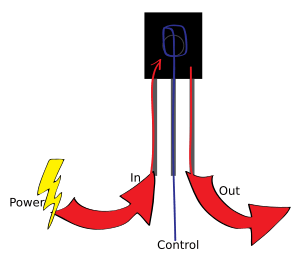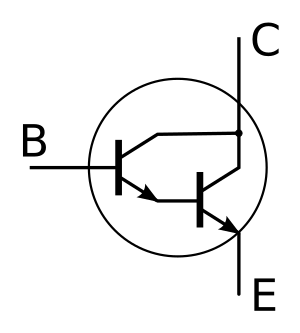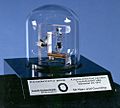Transistor facts for kids
A transistor is a tiny electronic part that can work like a super-fast switch or a sound booster (amplifier). It's made from special materials called semiconductors. You can find transistors in almost all electronic devices around you, like your phone, computer, and even your TV remote! They were a huge step forward from older, bigger parts called vacuum tubes because they use much less electricity and last a lot longer.
Transistors are used for many different things. In computers, they act as digital switches that turn on and off billions of times a second to process information. Most of these digital switches are a type called MOSFETs. Some transistors are sold separately, especially if they need to handle a lot of power. But most of the transistors you use every day are packed together inside tiny integrated circuits, also known as computer chips.
Contents
How Transistors Work
Imagine a transistor has three main connections, like tiny wires. These are usually called the gate, the drain, and the source. (On another type of transistor, they are called the emitter, the collector, and the base.)
Think of it like this:
- The source (or emitter) is where electricity tries to enter.
- The drain (or collector) is where electricity tries to leave.
- The gate (or base) is like a control knob.
Normally, if you just connect the source to the negative side of a battery and the drain to the positive side, no electricity will flow through the transistor. It's like a closed door. But when you put a small electric charge on the gate, it opens that door! This lets the electricity flow easily from the source to the drain. It's how a tiny signal can control a much bigger flow of electricity.
Visualizing How a Transistor Works
An easy way to understand a transistor is to think of it like a garden hose with a kink in it.
- The water in the hose is like the electricity (electrons).
- The kink in the hose stops the water from flowing.
- The gate of the transistor is like your hand. When you push on the kink (charge the gate), you straighten the hose, and the water (electricity) can flow through!
There's also a special type of transistor called a Darlington transistor. It's actually two transistors connected together in a clever way. This setup means that a super tiny amount of electricity on the first transistor's gate can control a very large amount of electricity flowing through the second transistor. This makes them great for situations where you need to control a lot of power with a very small signal.
What Transistors Are Used For
Transistors are incredibly useful because they can do two main things: act as a switch and act as an amplifier.
Transistors as Electronic Switches
When a transistor is used as a switch, a small electrical signal on its gate can turn a larger current completely on or off. This is super handy for electronics! Think about how a light switch works in your house – you push it, and the light turns on or off. Transistors do the same thing, but electronically, without any moving parts. This makes them much faster and more reliable than old-fashioned mechanical switches. They are the building blocks of all digital devices, like computers and smartphones, where information is processed using "on" (1) and "off" (0) signals.
Transistors as Amplifiers
Transistors can also make a small electrical signal much bigger. This is called amplifying. Imagine you're talking into a microphone, and your voice is a small electrical signal. If you send that signal through an amplifier with transistors, it can make your voice loud enough to fill a concert hall! In electronics, transistors take a small input current and use it to control a much larger output current, making the signal stronger. This is essential for things like radios, audio systems, and even the tiny signals that come from sensors.
What Transistors Are Made Of
Transistors are mostly made from special materials called semiconductors. The most common semiconductor used is silicon. Silicon is a chemical element found in the periodic table (in Group 14). It's very common and cheap, which is why it's used so much.
Another element, Germanium, which is also in Group 14, is sometimes used with silicon for special types of transistors. Scientists are also looking into making transistors from special forms of carbon, which could lead to even smaller and faster devices in the future. Sometimes, transistors are also made from compounds, which are combinations of different elements, like gallium arsenide.
History of Transistors
Before transistors, electronic devices used something called vacuum tubes. These tubes could also act as switches and amplifiers, just like transistors. However, vacuum tubes had many problems:
- They were big and fragile, like light bulbs.
- They used a lot of electricity and got very hot.
- They didn't last very long and often burned out.
The invention of the transistor solved all these problems! It was a huge breakthrough in electronics.
Three amazing physicists are given credit for inventing the first working transistor in 1947 at Bell Labs:
- Walter Houser Brattain
- John Bardeen
- William Shockley (who played a very important role in developing the theory behind them).
Why Transistors Are Important
The transistor is one of the most important inventions of the 20th century. Without it, our world would look completely different. Devices like cell phones, computers, and the internet might not even exist, or they would be huge, slow, and use tons of power.
Scientists and engineers have made transistors incredibly tiny – some are only dozens of atoms wide! This amazing shrinking ability means that billions of transistors can be packed onto a single, small computer chip. This is why modern devices are so powerful, fast, and compact. Transistors are truly the unsung heroes of the digital age!
Gallery
Images for kids
-
A Darlington transistor opened up so you can see the tiny chip inside. A Darlington transistor is like two transistors working together on one chip.
See also
 In Spanish: Transistor para niños
In Spanish: Transistor para niños















